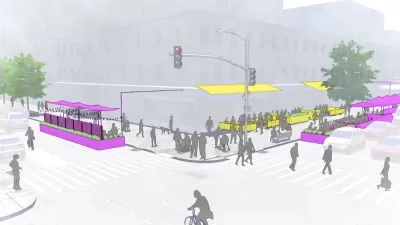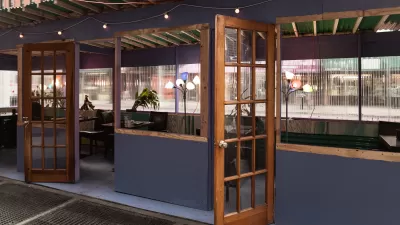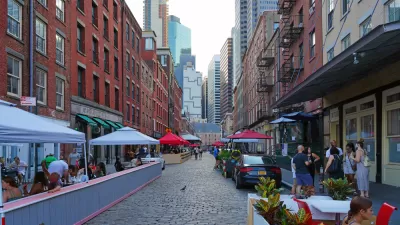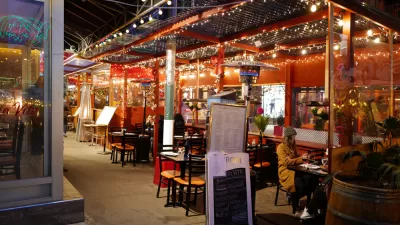New guidelines for the city’s ‘streeteries’ are set to go into effect next April.

New York City has released proposed designs for on-street dining setups, known locally as ‘streeteries,’ reports Christopher Bonanos in Curbed, in anticipation of a new program that will make the al fresco patios permanent—with some caveats.
As Bonanos explains, “As before, there are two types of setups. Those on the sidewalk will face minimal change. They’re going to be allowed year-round, much as they have for decades, under umbrellas and awnings. The city is lowering the price of the permit, which suggests a stance of benign encouragement.”
The design for ‘roadway sheds,’ on the other hand, will look vastly different from the Covid-era bubble enclosures. “The new open-air-dining experience will put the emphasis on the open-air part. Apart from the big heavy barrier meant to defend against moving vehicles, the mostly waist-high structures will be rather lightly constructed and roofless but for fabric canopies (an umbrella is always an option too).”
The on-street structures will have to be dismantled between November 31 and March 31. “That will allow the streets to be plowed, should it ever snow again, and perhaps diminish the number of winter-storm blow-downs.”
FULL STORY: The 2024 Streetery Is Taking Shape

Study: Maui’s Plan to Convert Vacation Rentals to Long-Term Housing Could Cause Nearly $1 Billion Economic Loss
The plan would reduce visitor accommodation by 25,% resulting in 1,900 jobs lost.

North Texas Transit Leaders Tout Benefits of TOD for Growing Region
At a summit focused on transit-oriented development, policymakers discussed how North Texas’ expanded light rail system can serve as a tool for economic growth.

Why Should We Subsidize Public Transportation?
Many public transit agencies face financial stress due to rising costs, declining fare revenue, and declining subsidies. Transit advocates must provide a strong business case for increasing public transit funding.

How to Make US Trains Faster
Changes to boarding platforms and a switch to electric trains could improve U.S. passenger rail service without the added cost of high-speed rail.

Columbia’s Revitalized ‘Loop’ Is a Hub for Local Entrepreneurs
A focus on small businesses is helping a commercial corridor in Columbia, Missouri thrive.

Invasive Insect Threatens Minnesota’s Ash Forests
The Emerald Ash Borer is a rapidly spreading invasive pest threatening Minnesota’s ash trees, and homeowners are encouraged to plant diverse replacement species, avoid moving ash firewood, and monitor for signs of infestation.
Urban Design for Planners 1: Software Tools
This six-course series explores essential urban design concepts using open source software and equips planners with the tools they need to participate fully in the urban design process.
Planning for Universal Design
Learn the tools for implementing Universal Design in planning regulations.
City of Santa Clarita
Ascent Environmental
Institute for Housing and Urban Development Studies (IHS)
City of Grandview
Harvard GSD Executive Education
Toledo-Lucas County Plan Commissions
Salt Lake City
NYU Wagner Graduate School of Public Service





























